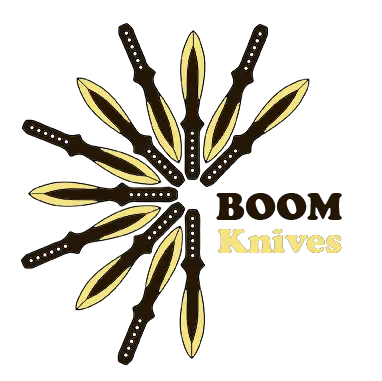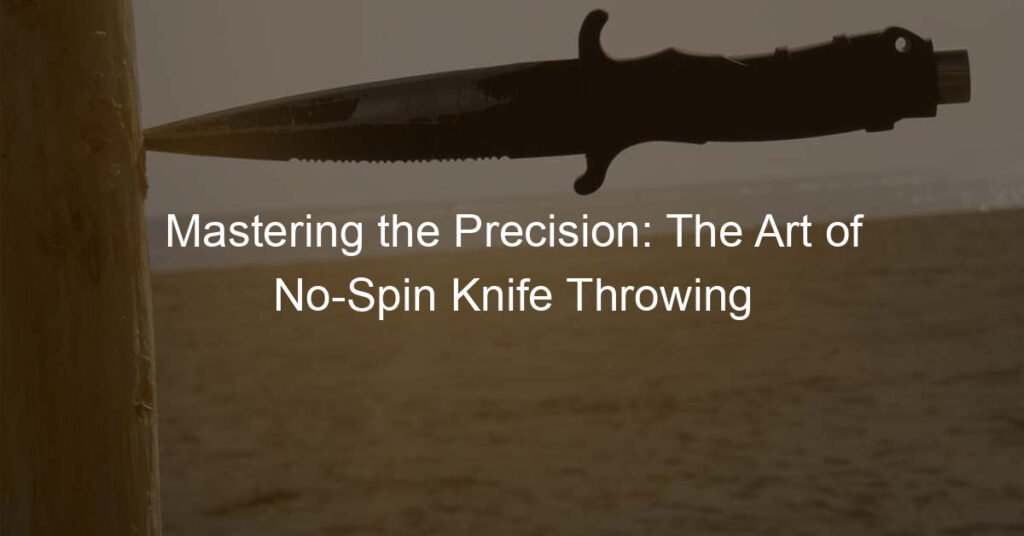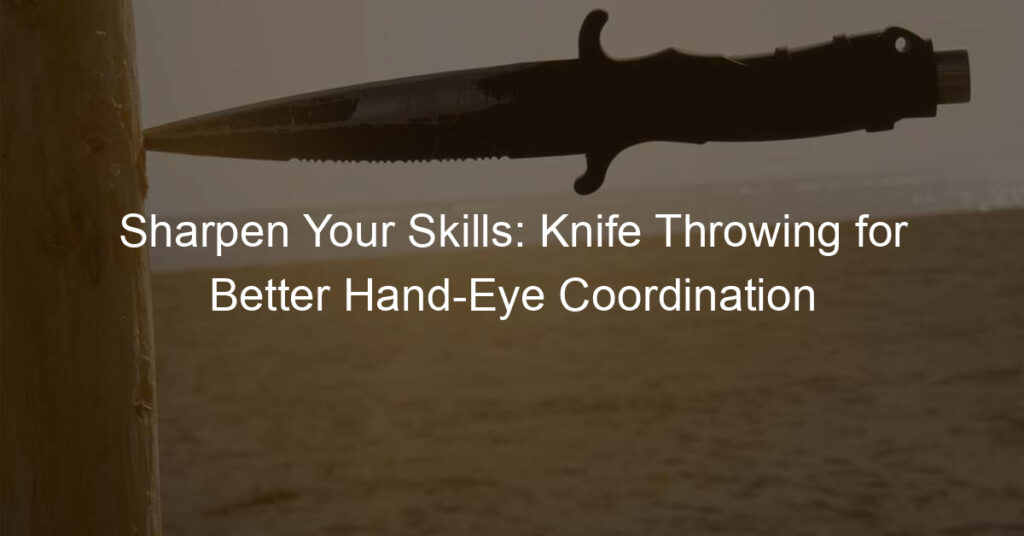Introduction to No-Spin Knife Throwing
Knife throwing is a fascinating skill that has been practiced for centuries. It requires focus, precision, and a deep understanding of the tools and techniques involved. One particular technique that has gained popularity is the no-spin knife throw. This article will guide you through the basics of this technique, its importance, and how to master it.
-
- Art of Knife Throwing
It was initially used for hunting and warfare but has evolved into a recreational activity and competitive sport. The art of knife throwing involves the precise control of a knife’s speed, direction, and rotation to hit a target accurately.
-
- Basics of No-Spin Knife Throw
This technique allows for more accurate and consistent throws, as the knife’s point always faces the target. The no-spin throw involves a specific grip, stance, and throwing motion.
-
- Precision in Knife Throwing
A precise throw ensures that the knife hits the target accurately and consistently. Precision involves controlling the knife’s speed, direction, and rotation. It also involves understanding the distance between you and the target, the weight of the knife, and how these factors affect the throw. Mastering precision in knife throwing takes practice and patience, but the result is a rewarding and impressive skill.
Knife Throwing Skills
Basic Knife Throwing Techniques
Before you can master the art of knife throwing, you need to understand and perfect the basic techniques. These include the proper grip for a no-spin throw, the correct stance and posture, and the throwing motion and release.
-
- Proper Grip for No-Spin Throw
For a no-spin throw, hold the knife by the handle with your thumb on one side and your index and middle fingers on the other. The knife should be held firmly but not too tightly. This grip allows the knife to leave your hand smoothly during the throw. For more information, you can check this
-
- Stance and Posture
Stand with your feet shoulder-width apart, with your dominant foot slightly forward. Keep your body straight and your shoulders relaxed. This stance provides a stable base for your throw.
-
- Throwing Motion and Release
Your arm should move in a straight line towards the target. The release point is crucial for a successful throw. Release the knife when your hand is at the highest point of the throw, and your arm is fully extended. This ensures the knife travels straight and hits the target point-first.
Mastering these basic knife throwing techniques is the first step towards becoming a skilled knife thrower. Practice these techniques regularly, and you’ll see your accuracy and precision improve over time.
Advanced Knife Throwing Techniques
Let’s explore some advanced techniques that will take your skills to the next level. These techniques require practice and dedication, but once mastered, they can significantly improve your performance.
-
Mastering the No-Spin Throw
This technique requires a delicate balance between the force applied and the release point. The key is to hold the knife by the handle and release it smoothly without imparting any spin.
-
Improving Precision and Accuracy
To improve these aspects, focus on your stance, grip, and release. Consistency is key. Practice the same motion repeatedly until you can hit your target accurately.
-
Increasing Throwing Distance
Start by practicing at a close distance, then gradually increase the distance as your strength and accuracy improve. Adjust your aim as the distance increases. The further the target, the higher you should aim.
| Technique | Description |
|---|---|
| No-Spin Throw | A technique where the knife does not rotate in the air before hitting the target. |
| Improving Precision and Accuracy | Focus on your stance, grip, and release. Practice the same motion repeatedly until you can hit your target accurately. |
| Increasing Throwing Distance | Start by practicing at a close distance, then gradually increase the distance as your strength and accuracy improve. |
Knife Throwing Training
Practice Drills for Beginners
Start with basic drills that help you understand the fundamentals of knife throwing. Here are three drills that can help you improve your skills:
- Target Practice Drills: Start with a large target and gradually reduce its size as you become more comfortable. This practice helps improve your focus and aim. For example, you can start by aiming at a large cardboard box and then move on to smaller targets like a dartboard.
- Distance Control Drills: Throwing a knife accurately from different distances is a key skill. Start by throwing from a close distance and gradually increase it. This will help you understand how much force is needed for different distances. The key is not to throw the knife as hard as you can, but to throw it accurately.
- Accuracy Improvement Drills: These drills involve throwing the knife at different parts of the target. For example, you can divide your target into different sections and aim for each one in turn. This will help you improve your accuracy and precision.
Training Tips for Advanced Throwers
Once you’ve mastered the basics of knife throwing, it’s time to take your skills to the next level. Here are some tips to help advanced throwers improve their technique and overcome common challenges.
-
- Consistency in Practice
It’s not just about practicing often, but also about practicing right. Make sure you’re using the same grip, stance, and throwing motion each time. This will help you develop muscle memory and improve your accuracy over time. Consistent practice can lead to long-lasting and stable changes in our ability to do certain tasks.
-
- Advanced Targeting Techniques
This involves not just hitting the target but hitting the exact spot you’re aiming for. One technique to try is the “point of focus” method. This involves focusing your eyes on the exact spot you want to hit, rather than the target as a whole. This can help improve your precision and accuracy.
-
- Overcoming Common Challenges
One common issue is over-rotation, where the knife spins too much before reaching the target. This can be fixed by adjusting your grip or throwing motion. Another challenge is dealing with different distances. Practice throwing from various distances to improve your versatility and adaptability.
Professional Knife Throwing
- Competing in Knife Throwing
It requires a combination of skill, strategy, and preparation. Here are some key steps to consider:
-
- Understanding Competition Rules
The rules typically cover aspects like the type of knives allowed, the distance from the target, and the scoring system. You can usually find these rules on the competition’s official website.
-
- Preparing for a Knife Throwing Competition
This includes both physical and mental preparation. Physically, you need to practice your throwing technique and build your strength and endurance. Mentally, you need to build your focus and learn to handle the pressure of competition. It’s also a good idea to familiarize yourself with the competition venue and equipment beforehand.
-
- Strategies for Winning a Competition
This could include studying your competitors, choosing the right knife for each throw, and knowing when to take risks.
Case Studies of Professional Knife Throwers
-
- Success Stories
One of the most inspiring success stories in the world of professional knife throwing is that of Bobby Briscoe. Starting as a hobbyist, Briscoe honed his skills over time and eventually won the World Knife Throwing Championship. His story is a testament to the power of dedication and practice.
-
- Lessons Learned
Every professional knife thrower has faced challenges and learned valuable lessons along the way. For instance, renowned thrower Adam Celadin emphasizes the importance of safety measures. He learned the hard way that neglecting safety can lead to serious injuries. This underscores the fact that safety should never be compromised, no matter how skilled a thrower may be.
-
- Key Takeaways
From these case studies, we can glean some key takeaways. Success in knife throwing requires dedication and consistent practice. Second, safety should always be a priority. And third, even the most accomplished throwers continue to learn and grow. As Celadin says, “There is always room for improvement.”
Conclusion: The Art of No-Spin Knife Throwing
-
- Recap of Mastering Knife Throwing
Throughout this blog post, we’ve delved into the art of no-spin knife throwing, starting with an introduction that set the stage for understanding this unique skill. We then moved on to mastering knife throwing skills, where we discussed the importance of grip, stance, and release. In the section on knife throwing training, we highlighted the importance of consistent practice and the use of appropriate targets. Finally, we looked at professional knife throwing, exploring how the pros do it and what we can learn from them.
-
- Final Tips and Tricks
Always ensure your safety and the safety of those around you when practicing. Don’t be discouraged by initial failures; even the best had to start somewhere. Knife throwing is as much about the journey as it is about the destination.
-
- Continuing Your Knife Throwing Journey
With the knowledge you’ve gained from this blog post, you’re well on your way to becoming a skilled no-spin knife thrower. Learning never stops. Continue to seek out new information, learn from others, and refine your skills. The world of knife throwing is vast and there’s always more to explore.







